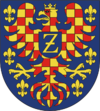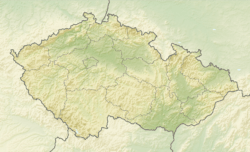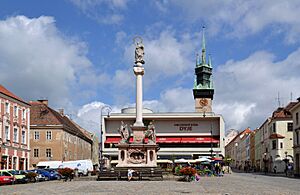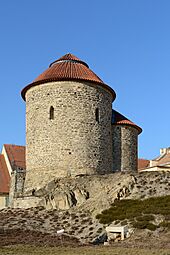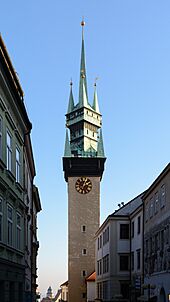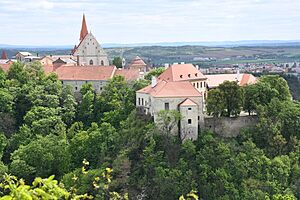Znojmo facts for kids
Quick facts for kids
Znojmo
|
|||
|---|---|---|---|
|
Town
|
|||

View from the south
|
|||
|
|||
| Country | |||
| Region | South Moravia | ||
| District | Znojmo | ||
| First mentioned | 1226 | ||
| Area | |||
| • Total | 65.90 km2 (25.44 sq mi) | ||
| Elevation | 290 m (950 ft) | ||
| Population
(2024-01-01)
|
|||
| • Total | 34,160 | ||
| • Density | 518.36/km2 (1,342.55/sq mi) | ||
| Time zone | UTC+1 (CET) | ||
| • Summer (DST) | UTC+2 (CEST) | ||
| Postal code |
669 02
|
||
Znojmo (Czech pronunciation: [ˈznoimo]; German: Znaim) is a town in the South Moravian Region of the Czech Republic. It has about 34,000 inhabitants. Znojmo is the historical and cultural centre of southwestern Moravia and the second most populated town in the South Moravian Region. The historic centre of Znojmo is well preserved and is protected by law as an urban monument reservation.
Contents
Administrative parts
The villages of Derflice, Kasárna, Konice, Mramotice, Načeratice, Oblekovice, Popice and Přímětice are administrative parts of Znojmo.
Etymology
The origin of the town's name is uncertain. According to the most likely theories, it was derived either from the Old Czech words znoj (i.e. 'heat') and znojný ('exposed to heat'), or from the personal name Znojem or Znojim.
Geography
Znojmo is located about 54 km (34 mi) southwest of Brno, near the border with Austria. It lies mostly in the Jevišovice Uplands, with only a small part of the municipal territory in the south extending into the Dyje–Svratka Valley. The highest point is at 397 m (1,302 ft) above sea level. The town is situated mainly on a rock outcropping on the steep left bank of the Thaya River. The western part of the municipal territory lies within the Podyjí National Park.
History
A settlement at the site possibly already existed during the time of the Great Moravian Empire in the 9th century, however, the main Great Moravian gord was situated on the hill across the Gránický brook. From about 1055, Znojmo Castle served as the residence of a Přemyslid principality within the Bohemian March of Moravia and a strategically important outpost near the border with the Bavarian March of Austria in the south. In 1101, Luitpold of Znojmo, Duke of Moravia, built the Rotunda of Saint Catherine in the castle.
The Znojmo Castle was seized and demolished by Duke Vladislaus II of Bohemia in 1145. In 1190, Duke Conrad II founded the Premonstratensian Louka Monastery at Znojmo.
The first written mention of Znojmo is from 1226. The royal town of Znojmo was founded shortly before 1226 by King Ottokar I of Bohemia on the plains in front of the rebuilt castle and was fortified. It was one of the first royal towns in Moravia. At that time, the burghers were mainly German speaking, while the surrounding villages were Czech speaking.
The town survived the Hussite Wars unscathed, when the Hussites failed to capture the town, and prospered. In the 15th and 16th centuries, networks of burgher houses with a system of underground passages were built as a part of fortifications. The Renaissance and late Gothic houses are preserved to this day. The development ended with the Thirty Years' War. Znojmo was conquered and ransacked repeatedly. It took over a hundred years for the town to recover.
From the 19th century, Znojmo is best known as the site for the Armistice of Znaim concluded there on 12 July 1809 after the Battle of Znaim, following the decisive Battle of Wagram, between Emperor Napoleon and the archduke Charles, which had taken place seven days earlier.
Since the end of World War I, Znojmo was within the newly established state of Czechoslovakia, except for 1938–1945 during the Nazi German occupation when it was administered as part of the Reichsgau Niederdonau. The German population of the town was expelled after World War II according to the Beneš decrees.
Demographics
| Historical population | ||||||||||||||||||||||||||||||||||||||||||||||||||||||||
|---|---|---|---|---|---|---|---|---|---|---|---|---|---|---|---|---|---|---|---|---|---|---|---|---|---|---|---|---|---|---|---|---|---|---|---|---|---|---|---|---|---|---|---|---|---|---|---|---|---|---|---|---|---|---|---|---|
|
|
|
||||||||||||||||||||||||||||||||||||||||||||||||||||||
| Source: Censuses | ||||||||||||||||||||||||||||||||||||||||||||||||||||||||
Economy
Znojmo is famous for local production of cucumbers, pickled in the original sweet-sour and spicy pickle, whose cultivation in the Znojmo region was introduced in 1571 by the abbot of the Louka Monastery, George II. The special taste is also the result of local type of cucumbers, cultivation method, soil, climatic conditions, processing and also the packaging in which they are kept.
Thanks to the favorable climatic conditions, the town is also successful in winery and fruit growing. It is the centre of viticulture of the Znojemská wine sub-region.
Transport
The I/38 (part of the European route E59) from Jihlava to the Czech-Austrian border passes through Znojmo. It forks in the centre of Znojmo and connects the town with Brno as the I/53 road.
There is a railway station with railway lines leading in three directions: to Vienna in Austria, to Břeclav and to Okříšky.
Culture
Znojmo is known for its Znojmo Vintage Festival which takes place every September. The main attraction of the festival is the historical parade commemorating the visit of King John of Bohemia to Znojmo in 1327.
The annual Gherkin Feast is dedicated to tradition of growing gherkins in the region.
Sport
1. SC Znojmo FK is a local football club competing in the Moravian–Silesian Football League (3rd tier of the Czech football league system).
Orli Znojmo is an ice hockey club playing in the Czech 2. Liga.
Sights
The Gothic Church of St. Nicholas and the late Gothic Town Hall tower are the most recognizable landmarks. The original church was founded in around 1100, and replaced by a new church gradually built from 1338 until the late 15th century. The town hall with its 80 m (260 ft) high tower was built in 1445–1448.
Overlooking the Thaya River valley, on the edge of the medieval city, is the Znojmo Castle, which was founded by the Přemyslid dukes in the 11th century. The only remaining trace of this castle is the Romanesque Rotunda of Saint Catherine, the interior of which is covered with 11th-century frescoes depicting scenes from the Bible and illustrating the life of Přemysl the Ploughman. The rotunda is protected as a national cultural monument.
Beneath the grounds of the old town, there is a vast labyrinth of connected passageways and cellars called the Znojmo Catacombs. This system was developed in the 14th and 15th centuries for defence purposes, and it contains wells, drainage, fireplaces, trap doors and escapeways that lead beyond the fortifications of the town. The catacombs are the largest system of underground corridors and cellars in the Czech Republic – they are almost 27 km (17 mi) long and up to 4 levels deep.
The Church of Saint Michael the Archangel was probably built in the 12th century. It is the second most significant church in the town, after Church of Saint Nicholas. The church was first mentioned in 1226 and completely rebuilt in the late Gothic style in 1508. It is considered a monument of national importance.
The Premonstratensian Louka Monastery is among the most valuable buildings in Znojmo. The monastery was founded in 1190, but the current monastery building was built in two phases in the years 1748–1756 and 1761–1778. Architecturally, it is a monument of transnational importance, protected as a national cultural monument. The monastery complex includes the Church of the Assumption of the Virgin Mary and Saint Wenceslaus. It is originally a Romanesque basilica with a Gothic presbytery, which was rebuilt in the Baroque style at the end of the 17th century.
Notable people
- Sigismund, Holy Roman Emperor (1368–1437), king of Bohemia; died here
- Prokop Diviš (1698–1765), inventor, catholic priest; served here in 1736–1741
- Clement Mary Hofbauer, C.Ss.R. (1751–1820), Redemptorist priest and saint; served here as an apprentice baker in 1767–1770
- Charles Sealsfield (1793–1864), German-American writer and lawyer
- Hugo Lederer (1871–1940), sculptor
- Otte Wallish (1903–1977), Israeli graphic designer
- Anna Spitzmüller (1903–2001), art historian and curator
- Edith Körner (1921–2000), British magistrate
- Franz Woidich (1921–2004), German fighter pilot
- Petr Rosol (born 1964), ice hockey player
- Jitka Schneiderová (born 1973), actress
- Květoslav Svoboda (born 1982), swimmer
- Michal Ordoš (born 1983), footballer
- Jiří Orság (born 1989), weightlifter
- Andrea Stašková (born 2000), footballer
Twin towns – sister cities
Znojmo is twinned with:
 Chrudim, Czech Republic
Chrudim, Czech Republic Nové Zámky, Slovakia
Nové Zámky, Slovakia Pontassieve, Italy
Pontassieve, Italy Povo (Trento), Italy
Povo (Trento), Italy Retz, Austria
Retz, Austria Ružinov (Bratislava), Slovakia
Ružinov (Bratislava), Slovakia Strzegom, Poland
Strzegom, Poland Torgau, Germany
Torgau, Germany Villazzano (Trento), Italy
Villazzano (Trento), Italy
See also
 In Spanish: Znojmo para niños
In Spanish: Znojmo para niños



